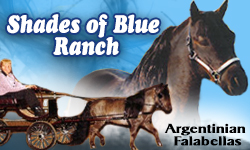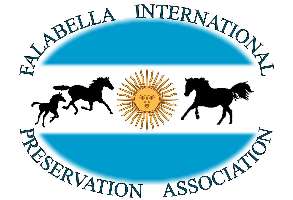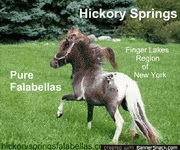Spotlight Farm Click image to visit Shades of Blue Ranch Illinois |


|
Stallion Showcase Click image to visit Hickory Springs Falabellas New York |
The Rare Falabella Miniature Horse
Written by and used with the permission of Tammie Cappuccio
The Falabella Miniature Horse is considered a breed in Argentina much as the Quarter Horse or American Miniature Horse is considered a breed in the United States. The Falabella family has selectively bred them for generations and has one of the longest recorded history's of any miniature horse association in the world.
Photos are available from as early as 1905 showing the breeding results of the Falabella in Argentina. The Falabella Miniature horse was the first line of miniature horses selectively bred anywhere in the world. Records go back as far as 150 years and via word of mouth and memory, may go even further.
Pedro Mendoza established the first horses, mainly Andalusian lines to South America in 1536. Many ran wild creating food and transportation for local Indians. Indians and settlers alike tended to take for their use the larger horses leaving the smaller horses to propagate. This continued for many generations and was the foundation of many of the South American breeds including the Criollo, which played a part in the development of the Falabella. Eventually horse-trading became profitable and a trader living in the Buenos Aires territory in 1845, Patrick Newtall, noticed a particular group of small horses in the wild horse herds. He obtained this group of small horses and started a selectively breeding them. Later infusions of Criollo and European Thoroughbred had also been introduced to the bloodline. Patrick Newtall and his son in law Mr. Juan Falabella joined to share knowledge to continue to improve the new evolving breed. The blood of Pur Sangs, Shetland (Dutch, English or Belgian type) were used and minis were being produced at less than 30 inches in height. Emilio and then Julio Cesar Falabella took on the responsibilities and records for the established breed called FALABELLA Miniature Horse.
Since the death of Julio Cesar Falabella his wife, Maria Louisa de Falabella has continued on at the Establecimientos (Est.). Falabella with the running and recording of the now famous miniature horses. Julio Cesar Falabella's daughter, Maria Angelica Falabella also continues to breed the Falabella miniature horses. Maria Angelica resides in the United States with a small group on her US farm of pure Falabella's and has a remaining herd in Argentina. The Est. Falabella handles the horse operations much as we do in the United states with the exception that they have yearly "inspections" of the young stock to establish which horses meet their breed standard and those not meeting it are sold. Once a Falabella has passed it's three-year-old year and meets all the requirements of inspection they are branded identifying them as approved breeding stock (they do not show their horses). The horses are divided on ten-acre parcels in-groups of mares with one stallion each. They remain outside without a barn or shelter year round. They are checked for health periodically and foaling season is kept busy recording the year's foals. The farm totals 600 individuals at last record. Only the existing genetic pool is used. Outside bloodlines are no longer used.
The only registry recognized by the Est. Falabella is the Asn. de Criadores de Cabballos Falabella (Assn. Of Falabella Breeders-ACCF). For the Imported Falabella horse will need to be hardshipped for entry into any of the registries (except the FMHA). The Falabella Registry (FMHA) was established in the United States (One of THE FIRST registries in the United States for miniature horses) to keep record of imported Falabellas coming in to the United States. The numbers of purebred Falabellas is still small due to their rarity but much sought after due to the improvement influence they can offer. Years of selective breeding for specific traits (not just size) has produced a hearty strong bloodline which consistently reproduces small and passes on a long legacy of a small, vigorous and flashy individuals. Falabella horses tend to average 28.5 although smaller and larger are found. Appaloosa and striking pinto are much sought after and a rarity. Their muscle and bone structure resembles a Quarter Horse and has a lively alert personality without lack of vigor. Pure Falabellas should have a registration from either the ACCF or the Falabella Miniature Horse Registry (FMHA). AMHA and AMHR will register them as "miniature horses" but pedigrees are not acknowledged and horses must be "hardshipped" in to receive registration from those registries.
Sellers of pure Falabella's should be able to supply a registration from ACCF, IMFHS or FMHA to prove the authenticity of a Falabella pedigree.
There are a few farms that specialize in the Falabella bloodline. Very limited numbers of horses are imported directly from the Est. Falabella. The Regina Winery in CA was one of the first to import Falabella's. The prices to directly purchase one horse and import from Est. Falabella starts at $8,000 and approved breeding stock can run up to $20,000. Prices are considerably lower in the United States.
You'll see famous names in modern pedigrees such as "CHIANTI" and "Grosshill's Comofin" as well in the show rings of yesterday and today. Consider this oldest breed of miniature horse for your breeding or show program.
Facts from Establecimientos Falabella.
|
Tell your friends about falabellainternational.com because WE LOVE FALABELLAS!!
|